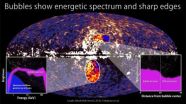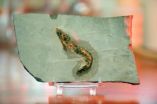(Press-News.org) WASHINGTON -- NASA's Fermi Gamma-ray Space Telescope has unveiled a previously unseen structure centered in the Milky Way. The feature spans 50,000 light-years and may be the remnant of an eruption from a supersized black hole at the center of our galaxy.
"What we see are two gamma-ray-emitting bubbles that extend 25,000 light-years north and south of the galactic center," said Doug Finkbeiner, an astronomer at the Harvard-Smithsonian Center for Astrophysics in Cambridge, Mass., who first recognized the feature. "We don't fully understand their nature or origin."
The structure spans more than half of the visible sky, from the constellation Virgo to the constellation Grus, and it may be millions of years old. A paper about the findings has been accepted for publication in The Astrophysical Journal.
Finkbeiner and Harvard graduate students Meng Su and Tracy Slatyer discovered the bubbles by processing publicly available data from Fermi's Large Area Telescope (LAT). The LAT is the most sensitive and highest-resolution gamma-ray detector ever launched. Gamma rays are the highest-energy form of light.
Other astronomers studying gamma rays hadn't detected the bubbles partly because of a fog of gamma rays that appears throughout the sky. The fog happens when particles moving near the speed of light interact with light and interstellar gas in the Milky Way. The LAT team constantly refines models to uncover new gamma-ray sources obscured by this so-called diffuse emission. By using various estimates of the fog, Finkbeiner and his colleagues were able to isolate it from the LAT data and unveil the giant bubbles.
Scientists now are conducting more analyses to better understand how the never-before-seen structure was formed. The bubble emissions are much more energetic than the gamma-ray fog seen elsewhere in the Milky Way. The bubbles also appear to have well-defined edges. The structure's shape and emissions suggest it was formed as a result of a large and relatively rapid energy release - the source of which remains a mystery.
One possibility includes a particle jet from the supermassive black hole at the galactic center. In many other galaxies, astronomers see fast particle jets powered by matter falling toward a central black hole. While there is no evidence the Milky Way's black hole has such a jet today, it may have in the past. The bubbles also may have formed as a result of gas outflows from a burst of star formation, perhaps the one that produced many massive star clusters in the Milky Way's center several million years ago.
"In other galaxies, we see that starbursts can drive enormous gas outflows," said David Spergel, a scientist at Princeton University in New Jersey. "Whatever the energy source behind these huge bubbles may be, it is connected to many deep questions in astrophysics."
Hints of the bubbles appear in earlier spacecraft data. X-ray observations from the German-led Roentgen Satellite suggested subtle evidence for bubble edges close to the galactic center, or in the same orientation as the Milky Way. NASA's Wilkinson Microwave Anisotropy Probe detected an excess of radio signals at the position of the gamma-ray bubbles.
The Fermi LAT team also revealed Tuesday the instrument's best picture of the gamma-ray sky, the result of two years of data collection.
"Fermi scans the entire sky every three hours, and as the mission continues and our exposure deepens, we see the extreme universe in progressively greater detail," said Julie McEnery, Fermi project scientist at NASA's Goddard Space Flight Center in Greenbelt, Md.
NASA's Fermi is an astrophysics and particle physics partnership, developed in collaboration with the U.S. Department of Energy, with important contributions from academic institutions and partners in France, Germany, Italy, Japan, Sweden and the United States.
"Since its launch in June 2008, Fermi repeatedly has proven itself to be a frontier facility, giving us new insights ranging from the nature of space-time to the first observations of a gamma-ray nova," said Jon Morse, Astrophysics Division director at NASA Headquarters in Washington. "These latest discoveries continue to demonstrate Fermi's outstanding performance."
INFORMATION:
For more information about Fermi, visit: http://www.nasa.gov/fermi
NASA's Fermi telescope discovers giant structure in our galaxy
2010-11-10
ELSE PRESS RELEASES FROM THIS DATE:
Researchers discover important link between adrenal gland hormone and brain in hypertension
2010-11-10
DALLAS – Nov. 9, 2010 – A hormone already responsible for increasing blood pressure by prompting the kidneys to retain salt appears to moonlight as a major stimulator of the brain centers that control the vascular system and blood pressure.
Researchers at UT Southwestern Medical Center studied patients who overproduce aldosterone to see whether the hormone had any effect on sympathetic nerve activity responsible for blood pressure increases.
"Between 10 percent and 20 percent of patients with high blood pressure who are resistant to treatment have elevated aldosterone ...
Astronomers find giant, previously unseen structure in our galaxy
2010-11-10
NASA's Fermi Gamma-ray Space Telescope has unveiled a previously unseen structure centered in the Milky Way -- a finding likened in terms of scale to the discovery of a new continent on Earth. The feature, which spans 50,000 light-years, may be the remnant of an eruption from a supersized black hole at the center of our galaxy.
"What we see are two gamma-ray-emitting bubbles that extend 25,000 light-years north and south of the galactic center," said Doug Finkbeiner, an astronomer at the Harvard-Smithsonian Center for Astrophysics (CfA) in Cambridge, Mass., who first ...
New brief tool to screen for cognitive impairment in elderly patients
2010-11-10
BOSTON—Dementia and cognitive impairment are widespread among elderly individuals in the United States, affecting more than 8 million people to some degree.
The Sweet 16, a new screening test developed by a team of geriatricians and neurologists at the Institute for Aging Research of Hebrew SeniorLife and Beth Israel Deaconess Medical Center, could help clinicians more rapidly detect dementia in elderly patients. The Sweet 16 will be available without charge to any nonprofit organization, and may provide an alternative to the Mini-Mental State Examination. The findings ...
Kent State geology professors study oldest fossil shrimp preserved with muscles
2010-11-10
One of America's favorite seafood is shrimp. Did you know that they fossilize as well? Rodney Feldmann, professor emeritus, and Carrie Schweitzer, associate professor, from Kent State University's Department of Geology report on the oldest fossil shrimp known to date in the world. The creature in stone is as much as 360 million years old and was found in Oklahoma. Even the muscles of the fossil are preserved. Their study will be published in Journal of Crustacean Biology.
"The oldest known shrimp prior to this discovery came from Madagascar," Feldmann said. "This one ...
How well does clot-busting drug work in stroke patients?
2010-11-10
MAYWOOD, Ill. -- The clot-busting drug rt-PA remains the most beneficial proven emergency treatment for strokes caused by blood clots, according to an editorial in the November issue of Archives of Neurology by Dr. José Biller.
"The benefits of treatment outweigh the risks in patients treated with intravenous rt-PA within 4.5 hours of symptom onset," Biller wrote. Biller is chairman of the Department of Neurology at Loyola University Chicago Stritch School of Medicine and an internationally recognized expert on stroke care.
Most strokes are ischemic, meaning they are ...
APHA 2010: College days -- more sedentary days
2010-11-10
During college years, students become more sedentary and as their physical activity levels decrease, Body Mass Index and weight increase.
"Basically, students came out of college significantly less active and heavier compared to the start of their freshman year," said Jeanne Johnston, assistant professor in the School of Health, Physical Education and Recreation. "But it is a gradual process."
She and her colleagues conducted a survey that asked a sample population of undergraduate students questions about physical activity. No matter what their year, college students ...
Study links a couple's numeracy skills with greater family wealth
2010-11-10
Couples who score well on a simple test of numeracy ability accumulate more wealth by middle age than couples who score poorly on such a test, according to a new study of married couples in the United States.
Researchers found that when both spouses answered three numeracy-related questions correctly, family wealth averaged $1.7 million, while among couples where neither spouse answered any questions correctly the average household wealth was $200,000. Numeracy is the ability to reason with numbers and other mathematical concepts, and are skills typically learned during ...
APHA 2010: Attacking the drinking culture on college campuses from different directions
2010-11-10
A multi-tiered effort designed to stem binge drinking at a large university and to change the drinking culture among its students produced notable results during the 2.5 years of an Indiana University study.
Freshmen living on campus showed significant drops in the average number of drinks consumed in a week; in the percentage who drank at least once a week in the last year; and in the proportion of students who engaged in binge drinking in the previous week.
Heavy drinking by college students and the associated consequences -- poor health and academic performance, ...
Schools Rush In For Solar Energy Grant
2010-11-10
Chief Executive Officer of ZEN Home Energy Systems, Richard Turner, reports the company has been 'inundated' with calls from schools wanting solar power systems before submissions close for the 2010-2011 funding round.
'We are currently speaking to 40 schools (for round two funding) across South Australia and Mildura to install solar panels. This is a 50% percent leap in demand from last year. We offer a solution to match with the schools funding budget and a consultative system design for the school with education and quality of the systems performance as the key ...
Four Rosendin Electric Projects Recognized as Construction and Design Winners by California Construction Magazine
2010-11-10
Rosendin Electric (www.rosendin.com), the nation's largest private electrical contractor and a 100-percent employee-owned company, today announced that four of its commercial construction projects received honors from California Construction magazine, including Best Overall Project and three Best of 2010 awards. In all, Rosendin Electric projects garnered five awards in four categories, including Best Overall Project, Best Government/Public Building project, Best Transportation Project, and two Healthcare awards for Best Project and an Award of Merit.
The Mineta San ...


